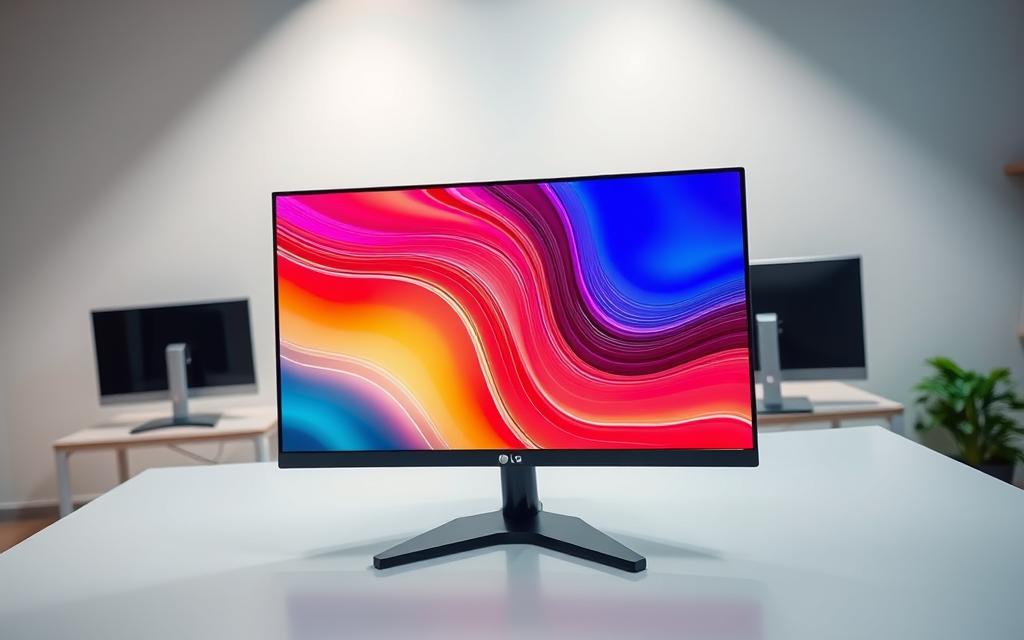Table of Contents
The LG C3 OLED TV sets a high standard for display performance, blending vivid colors, deep blacks, and smooth motion. Many users now seek similar excellence in dedicated screens for work and play.
Demand grows for displays that match the C3’s strengths—OLED clarity, high refresh rates, and HDR brilliance. Gamers, designers, and professionals want this level of quality without compromise.
This guide explores top contenders that deliver comparable features. We’ll analyze key specs like response time, color accuracy, and connectivity. Real-world testing and expert reviews help identify the best options.
Whether you prioritize speed for competitive gaming or precision for creative tasks, there’s a worthy alternative. Let’s dive into the details to find your ideal match.
Introduction: What Makes the LG C3 OLED TV Special?
Few displays deliver the visual brilliance of the LG C3 OLED. Its cutting-edge technology sets a benchmark for both entertainment and professional use. With deep blacks, vibrant colors, and lightning-fast response, it redefines expectations.
Key Features of the LG C3 OLED
The WOLED panel ensures perfect blacks and a near-infinite contrast ratio. Combined with LG’s α9 AI Processor Gen6, images appear sharper and more lifelike. This makes every scene pop with stunning clarity.
For smooth gameplay, the 120Hz refresh rate eliminates motion blur. HDMI 2.1 ports support 4K resolution at this speed, ideal for next-gen consoles. Gamers enjoy fluid action without lag or stuttering.
Color accuracy is another standout feature. With 100% DCI-P3 coverage, it meets professional standards for creative work. HDR10 and Dolby Vision support further enhance dynamic range for immersive content.
Why Gamers and Content Creators Love the C3
Competitive players benefit from the 0.1ms response time and minimal input lag. According to RTINGS, it scores 9.4/10 as a gaming display. Fast-paced titles feel incredibly responsive.
Creators appreciate the precise color reproduction and anti-glare coating. Wide viewing angles ensure consistency, even in bright rooms. Whether editing photos or streaming, the screen delivers reliable performance.
From cinematic visuals to high-speed action, the C3 excels in every scenario. Its versatility makes it a top choice for diverse needs.
What LG Computer Monitor Is as Good as the C3?
Finding a display that rivals the C3’s excellence requires careful evaluation. Professionals and gamers need screens with comparable color depth, speed, and clarity. Let’s break down the key criteria for a worthy alternative.
Essential Features for Parity
4K resolution and HDR600+ certification are non-negotiable for sharp, vibrant visuals. The C3’s OLED panel delivers perfect blacks—aim for a contrast ratio of 1,000,000:1 in competing models.
For smooth gameplay, prioritize a 120Hz+ refresh rate and HDMI 2.1 support. This ensures lag-free 4K gaming, matching the C3’s responsiveness. Input lag below 10ms is ideal for competitive play.
Color accuracy matters for creators. Look for 100% DCI-P3 coverage and factory calibration. Burn-in prevention tools, like pixel shifting, extend longevity for static UIs.
Form Factor and Value
Ergonomics differentiate monitors from TVs. Adjustable stands and VESA mounts enhance workspace flexibility. Weigh price against performance—premium OLED models often justify their cost with superior user experience.
Testing by RTINGS confirms that few monitors match the C3’s balance of speed and fidelity. However, select LG models come close, blending OLED brilliance with desktop-friendly designs.
LG OLED Flex: A Curved Alternative to the C3
Curved displays offer a unique blend of immersion and performance, setting them apart from traditional flat screens. The LG OLED Flex takes this further with a 42-inch panel and adjustable 900R curvature, adapting to your needs. Whether gaming or multitasking, its flexibility enhances the viewing experience.
Flexibility and Gaming Performance
The Flex’s curvature adjusts from flat to deeply curved, wrapping you in action-packed scenes. A 120Hz refresh rate and 0.03ms response time rival top-tier monitors, ensuring smooth gameplay. Features like Black Stabilizer and Crosshair give competitive players an edge.
With 700-nit peak brightness, it’s 70% brighter than standard OLEDs. HDR content pops, though it falls slightly short of the C3’s Dolby Vision brilliance. Input lag clocks at 5ms—faster than the C3’s 9.4ms in Game Mode.
Pros and Cons Compared to the C3
Advantages:
- Adjustable curvature for personalized immersion
- Superior input lag and response time
- 98.5% DCI-P3 coverage for vibrant colors
Limitations:
- Fixed stand lacks wall-mounting options
- Higher price ($1,999) than C3’s TV variants
- Smaller size range vs. C3’s 42”–83” options
For gamers craving speed and adaptability, the Flex excels. Yet, those prioritizing cinematic HDR or larger screens may prefer the C3’s versatility.
LG UltraFine 32EP950: Professional-Grade OLED Monitor
Creative workflows require displays with unmatched accuracy—enter the LG UltraFine 32EP950. This 31.5″ 4K OLED panel targets photographers, videographers, and designers who prioritize precision. With a 1,000,000:1 contrast ratio and 99% Adobe RGB coverage, it rivals high-end reference screens.
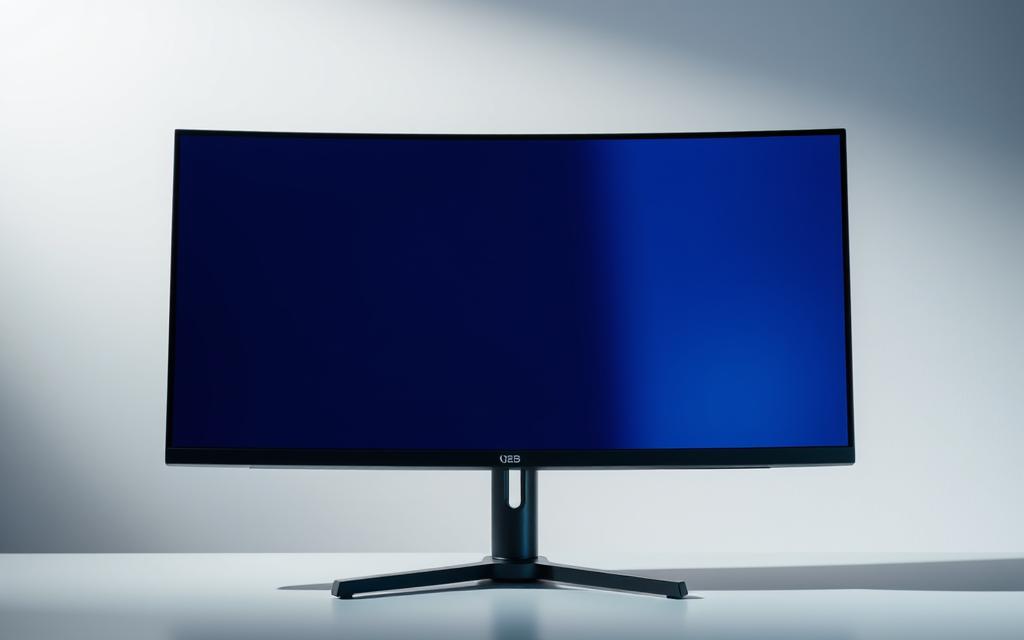
Color Accuracy and HDR Performance
Factory calibration ensures delta-E ≤2, making it ready for color-critical tasks out of the box. The 3D LUT hardware calibration tool allows fine-tuning for specific workflows. Compared to the C3’s consumer-focused presets, the 32EP950 excels in consistency.
HDR True Black 400 certification ensures deep shadows, though it lacks the C3’s Dolby Vision support. Professional features like a waveform monitor and HDR10+ compatibility cater to video editors. For static content creation, its anti-glare coating reduces eye strain.
How It Stacks Up Against the C3
The 60Hz refresh rate is a clear trade-off for creators prioritizing fidelity over gaming speed. Connectivity favors pros too, with DisplayPort 1.4 outpacing HDMI 2.1 for color depth in studio setups.
- Burn-in protection: Includes pixel refresh and a 1-year warranty for peace of mind.
- Ergonomics: VESA mount compatibility and tilt adjustment suit desk setups.
- Price: At $3,999, it’s a niche investment justified by its reference-grade performance.
While the C3 dominates living rooms, the 32EP950 claims workspaces with tools tailored for content mastery. Choose it if color accuracy outweighs gaming versatility.
LG 27GR95QE-B: A Gaming Powerhouse
Competitive gaming demands lightning-fast performance—enter the LG 27GR95QE-B. This 27-inch OLED beast combines esports-ready speed with stunning visuals, making it a top contender for players who refuse to compromise.
240Hz Refresh Rate and OLED Speed
A blistering 240Hz refresh rate and 0.03ms response time eliminate motion blur in fast-paced titles. NVIDIA G-SYNC compatibility ensures tear-free gameplay, while 98.5% DCI-P3 coverage delivers vibrant colors.
Compared to the C3’s 120Hz, this screen offers twice the smoothness. Pro gamers report sharper tracking in games like Valorant and Call of Duty.
“The difference between 120Hz and 240Hz is night and day. Targets feel glued to my crosshair.”
Gaming Experience vs. the C3
Input lag clocks at 2.1ms—over 4x faster than the C3’s 9.4ms. HDR600 certification provides decent contrast, though the C3’s higher brightness wins for cinematic scenes.
| Feature | 27GR95QE-B | C3 |
|---|---|---|
| Refresh Rate | 240Hz | 120Hz |
| Response Time | 0.03ms | 0.1ms |
| Input Lag | 2.1ms | 9.4ms |
| HDR | HDR600 | Dolby Vision |
The 27″ size is ideal for desk setups, offering better peripheral vision than larger displays. Multi-monitor configurations are easier to manage compared to a single 42″ C3.
Text clarity suffers slightly due to non-RGB subpixels, but gamers prioritize motion over spreadsheets. At $999, it’s a premium investment for dedicated play.
LG 48GQ900-B: Big-Screen Gaming Monitor
Gamers craving expansive visuals without sacrificing performance will love the LG 48GQ900-B. This 47.5-inch OLED powerhouse blends cinematic immersion with competitive specs, making it a standout choice for both console and PC enthusiasts.
4K 120Hz Performance
With a 1,500,000:1 contrast ratio and 135% sRGB coverage, colors pop with stunning vibrancy. DisplayHDR 400 True Black certification ensures deep shadows and bright highlights, though it falls short of the C3’s Dolby Vision support.
Key advantages for players:
- 4K resolution at 120Hz for smooth, detailed gameplay
- HDMI 2.1 bandwidth supports next-gen consoles
- Near-instant 0.1ms response time eliminates ghosting
“The size-to-performance ratio is perfect for my racing sim—it feels like I’m in the cockpit.”
Size and Immersion Compared to the C3
At 48 inches, this display offers a unique middle ground between traditional monitors and TVs. Pixel density sits at 91 PPI versus the C3’s 104 PPI, but the difference is negligible beyond 3 feet.
Consider these factors:
- Desk use: Requires deeper setups (4+ feet viewing distance)
- Ergonomics: Fixed stand lacks height adjustment vs. TV wall-mounting
- Burn-in risk: Pixel refresher helps, but static HUDs demand caution
Priced at $1,299, it targets serious gamers who prioritize both scale and speed. While the C3 excels in living rooms, the 48GQ900-B dominates desk-based battlestations.
LG 32GQ850: High Refresh Rate for Competitive Gaming
Speed and precision define the LG 32GQ850, a top pick for competitive players. Its overclockable 240Hz refresh rate and 1ms response time eliminate motion blur, giving gamers a tangible edge. While it trades OLED’s perfect blacks for IPS reliability, the trade-offs cater to fast-paced action.
144Hz and Beyond: Smooth Gameplay
The 32GQ850’s 240Hz mode transforms high-speed scenes into fluid visuals. NVIDIA G-SYNC compatibility reduces tearing, while HDR600 enhances contrast for vibrant explosions and shadows. Compared to OLED, IPS panels like this offer better longevity for static UIs—a plus for multiplayer lobbies.
Key advantages for esports:
- Input lag: 1ms (vs. C3’s 9.4ms) for near-instant reactions
- Motion clarity: Backlight strobing reduces blur during rapid turns
- Color coverage: 95% DCI-P3 ensures accurate hues without oversaturation
Trade-Offs vs. the C3’s OLED Panel
IPS technology can’t match OLED’s infinite contrast, but it compensates with practicality. The 32GQ850 avoids burn-in risks during marathon sessions, and its matte coating minimizes glare under bright lights.
| Feature | 32GQ850 | C3 |
|---|---|---|
| Panel Type | IPS | OLED |
| Refresh Rate | 240Hz | 120Hz |
| Response Time | 1ms GTG | 0.1ms |
| HDR | HDR600 | Dolby Vision |
“The 240Hz refresh makes tracking enemies effortless—it’s like playing on easy mode.”
Priced at $799, this model offers a budget-friendly path to elite performance. While the C3 excels in cinematic immersion, the 32GQ850 dominates in raw speed and durability.
LG 34GP950G-B: Ultrawide for Immersive Gaming
Ultrawide displays redefine immersion, offering expansive views that standard 16:9 screens can’t match. The LG 34GP950G-B elevates this with a 3440×1440 resolution and 180Hz refresh rate, blending speed with cinematic scale.
Ultrawide vs. 16:9: Which Delivers Better Performance?
A 21:9 aspect ratio provides 33% more horizontal space than 16:9. This enhances productivity with seamless split-screen workflows. Gamers gain a wider field of view, spotting enemies earlier in titles like Fortnite.
Pixel density sits at 110 PPI—sharper than the C3’s 104 PPI at similar viewing distances. However, 4K content scales unevenly on ultrawide screens, requiring GPU power to render 5 million extra pixels.
Aspect Ratio and HDR Face-Off
The 34GP950G-B’s VESA DisplayHDR 600 certification ensures vibrant contrasts, though it lacks the C3’s Dolby Vision depth. For creators, 98% DCI-P3 coverage ensures accurate hues across the wider screen.
| Feature | 34GP950G-B (21:9) | C3 (16:9) |
|---|---|---|
| Resolution | 3440×1440 | 3840×2160 |
| Refresh Rate | 180Hz | 120Hz |
| HDR | HDR600 | Dolby Vision |
| Pixel Density | 110 PPI | 104 PPI |
“Racing games feel lifelike on ultrawide—it’s like wearing peripheral vision goggles.”
Console gamers face limitations: PS5 and Xbox Series X don’t natively support 21:9. At $1,299, this model targets PC users prioritizing immersion over TV versatility.
LG 27UK850-W: Budget-Friendly 4K Option
Balancing performance and affordability, the LG 27UK850-W stands out as a practical choice for users seeking crisp visuals without breaking the bank. Its 4K resolution and IPS panel deliver vibrant colors, making it ideal for both work and casual gaming.
Affordability and Performance
This model shines with 98% sRGB coverage, ensuring accurate colors for photo editing and streaming. The HDR10 support enhances contrast, though it can’t match the C3’s OLED depth. USB-C connectivity with 60W power delivery simplifies setups for laptops and tablets.
Key advantages:
- Sharp text clarity: Ideal for coding or document-heavy tasks
- Versatile connectivity: HDMI, DisplayPort, and USB-C options
- Ergonomic stand: Height and tilt adjustments for comfort
Where It Falls Short of the C3
The 60Hz refresh rate limits smoothness in fast-paced games. HDR400 performance pales next to the C3’s Dolby Vision, with lower peak brightness affecting dynamic range.
| Feature | 27UK850-W | C3 |
|---|---|---|
| Refresh Rate | 60Hz | 120Hz |
| HDR | HDR400 | Dolby Vision |
| Panel Type | IPS | OLED |
“For office work and indie games, it’s perfect. Competitive players should look elsewhere.”
Priced under $500, it’s a smart pick for budget-conscious users prioritizing resolution over high-speed performance. While it lacks premium features, its reliability makes it a solid long-term investment.
LG 38WN95C-W: Productivity Meets Gaming
Work and play collide seamlessly with the LG 38WN95C-W, a display built for multitaskers. Its 3840×1600 resolution and 144Hz refresh rate cater to creators and gamers alike. Thunderbolt 4 connectivity and 98% DCI-P3 coverage further elevate its versatility.
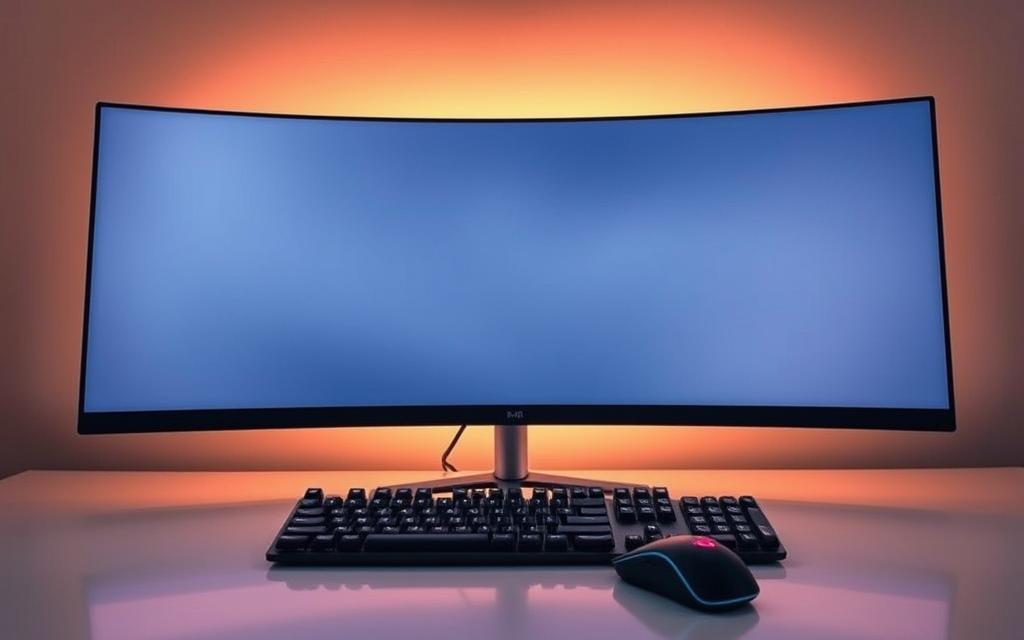
Multitasking and Display Quality
The 24:10 aspect ratio offers 30% more vertical space than 16:9 screens. Spreadsheets, timelines, and code editors benefit from the extra room. HDR600 ensures vibrant contrasts, though it lacks the C3’s Dolby Vision depth.
Color accuracy shines with factory calibration (delta-E ≤2). Video editors appreciate the consistency across the wide screen. Matte coating reduces glare, making it ideal for bright studios.
Gaming Performance vs. the C3
144Hz refresh rates deliver smooth gameplay, outpacing the C3’s 120Hz. NVIDIA G-SYNC compatibility minimizes tearing in fast-paced titles. However, the IPS panel’s 1000:1 contrast ratio falls short of OLED’s infinite depth.
- Thunderbolt 4: Powers laptops while transmitting video—perfect for hybrid setups.
- Ergonomics: Height-adjustable stand suits long work sessions.
- Price: At $1,599, it targets professionals needing speed and space.
“The extra height lets me edit videos and monitor chats without switching windows.”
For those prioritizing workflow efficiency and casual gaming, the 38WN95C-W excels. Hardcore players may prefer the C3’s superior HDR, but multitaskers gain unmatched productivity.
OLED vs. QLED: Which Technology Wins?
Display technology battles rage between OLED and QLED, each with distinct strengths. While OLED delivers perfect blacks, QLED counters with unmatched brightness. Deciding which excels depends on your needs—be it gaming, content creation, or everyday use.
Panel Technology Breakdown
OLED panels use self-emissive pixels for true blacks and infinite contrast. This makes them ideal for dark rooms and HDR content. QLED relies on quantum dots and LED backlights, hitting 1,500+ nits for sunlit visibility.
Key differences:
- Viewing angles: OLED maintains accuracy up to 84°, while QLED dims beyond 50°.
- Reflections: QLED’s anti-glare coatings outperform OLED in bright spaces.
- Burn-in: OLED risks image retention with static UIs; QLED avoids this.
HDR and Color Performance
OLED’s per-pixel lighting enables precise HDR, but QLED’s brightness highlights specular details. For creators, OLED covers 100% DCI-P3, while QLED reaches 95% but with higher luminance.
| Feature | OLED | QLED |
|---|---|---|
| Contrast Ratio | Infinite | 6,000:1 |
| Peak Brightness | 800 nits | 1,500+ nits |
| Color Volume | 85% | 92% |
“QLED dominates daylight viewing, but OLED’s contrast is unbeatable for cinematic immersion.”
Gaming and Professional Use
OLED’s 0.1ms response time suits competitive gaming, while QLED’s 144Hz+ refresh rates excel in fast-paced scenes. Creators favor OLED for color accuracy, but QLED’s brightness aids video editing in bright studios.
Price-wise, QLED monitors often cost 30% less than OLED equivalents. Yet, OLED’s longevity and premium feel justify the gap for many.
Refresh Rates Explained: 120Hz vs. 144Hz vs. 240Hz
Smooth gameplay hinges on refresh rates, yet not all numbers deliver equal benefits. Higher values reduce motion blur and input lag, but human eyes perceive diminishing returns beyond 200Hz. This breakdown clarifies what each tier offers for competitive and casual play.
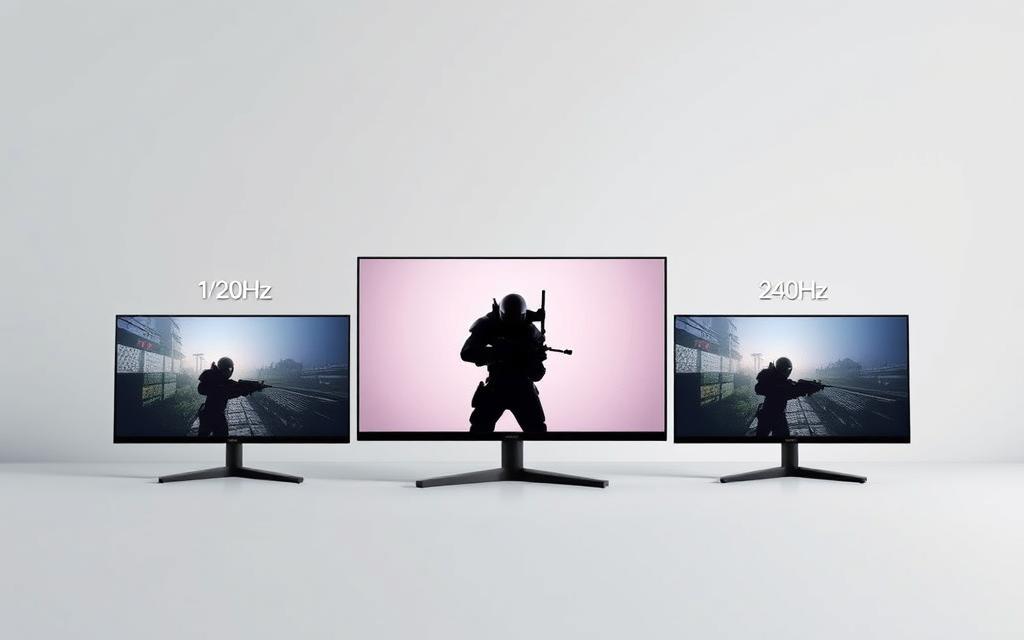
What Gamers Need to Know
120Hz suits console gaming and cinematic experiences, balancing fluidity with GPU demands. Titles like God of War benefit from this sweet spot, especially on HDMI 2.1 devices.
144Hz dominates PC gaming, offering noticeable smoothness over 120Hz. Fast-paced shooters like CS:GO gain a competitive edge with reduced tearing when paired with FreeSync or G-SYNC.
240Hz caters to esports professionals. At 0.03ms response times, it minimizes ghosting—critical for tracking enemies in Valorant. However, GPU requirements spike exponentially.
“Beyond 144Hz, the difference becomes harder to spot unless you’re a pro. Prioritize panel quality over raw speed for most setups.”
C3’s 120Hz Performance in Context
The C3’s 120Hz refresh rate excels for consoles, matching the PS5 and Xbox Series X cap. RTINGS’ 9.4/10 gaming score highlights its near-instant response (9.4ms input lag) and Dolby Vision support.
For PC gamers, 144Hz or 240Hz monitors often outperform the C3 in raw speed. However, the TV’s OLED contrast and HDR immersion remain unmatched for cinematic titles.
| Refresh Rate | Best For | GPU Requirement |
|---|---|---|
| 120Hz | Consoles, casual gaming | RTX 3060+ |
| 144Hz | Competitive PC gaming | RTX 3070+ |
| 240Hz | Esports professionals | RTX 4080+ |
Variable Refresh Rate (VRR) technologies like FreeSync Premium Pro enhance all tiers, eliminating stutter without taxing hardware. Future-proofing depends on your priorities—resolution or frame rate.
Size Matters: Choosing Between 27-Inch and 48-Inch Monitors
Selecting the right display size impacts both productivity and immersion. Larger screens wrap you in content, while compact ones fit tighter workspaces. The LG C3’s 42-inch panel strikes a balance, but alternatives cater to specific needs.
Desk Space and Viewing Distance
A 27-inch screen suits most desks, requiring just 2–3 feet of viewing distance. Pixel density stays sharp (~163 PPI), ideal for text-heavy tasks. Multi-monitor setups thrive here, with minimal bezel interference.
At 48 inches, viewing distance jumps to 4+ feet. While immersive for gaming, text readability suffers (~91 PPI) without scaling. Weight and heat output also rise, demanding sturdy mounts.
How the C3’s 42-Inch Size Compares
The C3’s 42-inch variant offers a middle ground with 104 PPI. Users report smoother transitions from smaller screens versus 48-inch models. Its 16:9 ratio aligns with mainstream content, avoiding ultrawide scaling issues.
“Switching from dual 27-inch monitors to the 42-inch C3 streamlined my workflow. No more bezel gaps, and HDR movies feel theater-like.”
- Productivity: 27-inch excels for coding; 42-inch better for timelines.
- Immersion: 48-inch dominates sim racing; 42-inch balances movies and work.
- Heat: Larger panels run warmer—ventilation matters for marathon sessions.
Ultimately, prioritize your experience. Compact screens maximize efficiency, while larger ones elevate entertainment. The C3’s versatility makes it a compelling hybrid.
User Experience: Real-World Feedback on LG Monitors
Real-world feedback reveals how LG displays perform beyond spec sheets. Professional reviewers and everyday users provide invaluable insights into long-term usability. These perspectives help identify strengths that lab tests might miss—and quirks that only emerge during daily use.
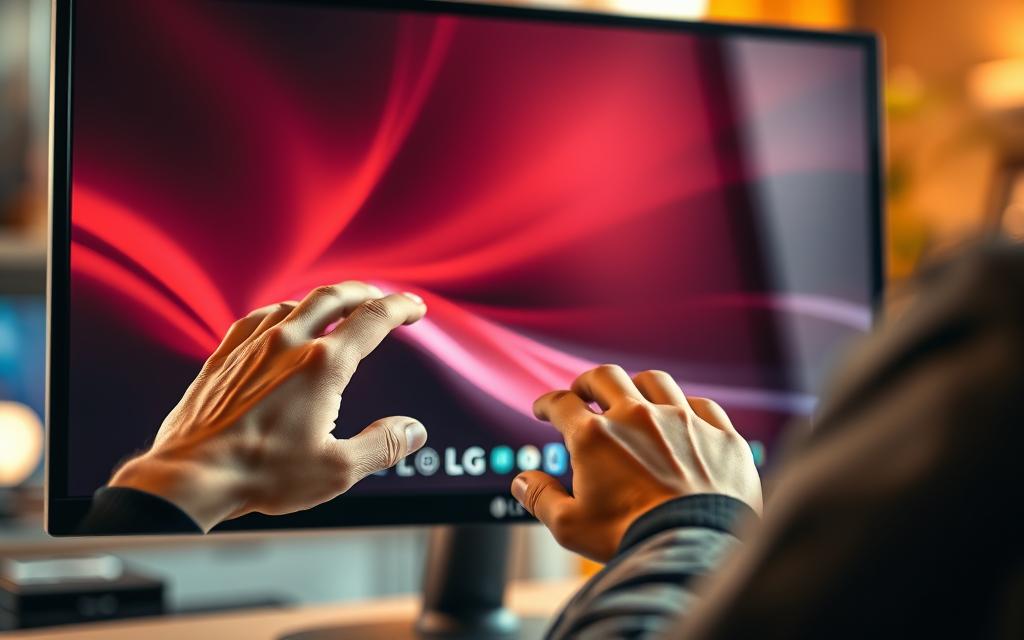
Transitioning From TV to Monitor: User Reports
Many adopters switching from the C3 TV to dedicated monitors report immediate differences. Text clarity often improves due to higher pixel density, while HDR impact varies by model. One Reddit user noted:
“Moving from my 48-inch C3 to the 27GR95QE-B felt like trading a movie theater for an esports arena. Colors pop less, but I can finally see enemy outlines clearly in Warzone.”
Common adjustment challenges include:
- Workflow changes: Ultrawide screens boost productivity but require app repositioning
- HDR adjustments: Monitors often lack the C3’s Dolby Vision brightness
- Viewing angles: IPS panels show more color shift than OLED when off-center
Daily Use: Where the C3 Excels and Struggles
Professional reviewers highlight the C3’s unmatched contrast for movie nights. However, static desktop UIs pose burn-in risks over time. RTINGS’ 6-month test showed faint taskbar retention after 4,000 hours.
For mixed usage, users praise:
- Seamless console/PC switching via HDMI 2.1
- Built-in smart TV apps for casual viewing
- Uniform brightness across the entire panel
Gaming-specific feedback notes the 120Hz cap feels limiting after trying 240Hz monitors. Yet, the C3’s motion handling remains superior for cinematic titles. As one AVSForum member described:
“Playing Elden Ring on the C3 versus my old IPS monitor is like comparing an IMAX screen to a smartphone. The OLED depth makes every dungeon crawl terrifyingly real.”
Warranty differences also impact long-term experience. LG’s monitor protection often excludes burn-in, while TV warranties sometimes cover it under “panel defects.” This affects purchasing decisions for static content creators.
Price vs. Performance: Finding the Best Value
Balancing cost and quality is crucial when selecting a high-performance display. The LG C3 OLED sets a premium benchmark, but alternatives exist at various price points. This breakdown helps you identify the sweet spot for your needs.
Evaluating the C3’s Premium
At $1,299 MSRP, the C3 justifies its cost with unmatched OLED contrast and Dolby Vision. However, budget-conscious buyers should consider:
- Lifespan: OLED panels average 30,000 hours vs. 50,000+ for IPS.
- Hidden costs: Calibration tools ($200+) may be needed for professional work.
- Depreciation: TVs lose 40% value in 2 years; monitors hold better resale.
“For cinematic HDR, nothing beats the C3. But my 27GR95QE-B saves $300 and delivers 240Hz for esports.”
Top LG Picks by Budget
From entry-level to pro-tier, here’s where to allocate your funds:
| Budget | Best Option | Key Advantage |
|---|---|---|
| $400-$700 | 27UK850-W | 4K clarity for office/indie gaming |
| $800-$1,200 | 32GQ850 | 240Hz speed for competitive play |
| $1,300+ | 48GQ900-B | Big-screen immersion with 120Hz |
Black Friday often sees 25% discounts on older models. Warranty terms vary—monitors typically cover 1-3 years, while TVs may include burn-in protection.
For creative professionals, the 32EP950’s color accuracy outweighs its $3,999 price. Casual users can save 60% with the 27UK850-W without sacrificing essential features.
Ultimately, prioritize your primary use case. The C3 excels in living rooms, while dedicated screens offer tailored gaming or content creation benefits. Test displays in person when possible—real-world experience often reveals unexpected preferences.
Conclusion: Which LG Monitor Is Right for You?
Choosing the perfect display depends on your priorities. Competitive gaming demands high refresh rates—opt for the 27GR95QE-B’s 240Hz speed. Creators need color precision, making the 32EP950 a top pick.
For mixed usage, the C3 OLED balances cinematic visuals and console compatibility. Budget-focused users can consider the 27UK850-W, offering 4K clarity without premium costs.
Future-proofing matters. OLED dominates contrast, while QLED excels in brightness. Test panels in person when possible to gauge real-world experience.
Still unsure? Match your primary use case—speed for esports, accuracy for content, or versatility for entertainment. Each model here delivers excellence tailored to different needs.
FAQ
Which LG monitor offers similar OLED quality to the C3?
The LG 27GR95QE-B delivers stunning OLED visuals with a 240Hz refresh rate, making it a top choice for gamers who want C3-like performance.
Is a 120Hz refresh rate enough for competitive gaming?
While 120Hz provides smooth gameplay, monitors like the LG 32GQ850 with 144Hz or higher offer better responsiveness for fast-paced titles.
How does the LG UltraFine 32EP950 compare to the C3 for content creation?
The 32EP950 excels in color accuracy and HDR, making it ideal for professionals, while the C3 shines in larger-screen entertainment.
What’s the difference between OLED and QLED for gaming?
OLED offers deeper blacks and faster response times, like the C3, while QLED provides brighter screens with higher peak brightness.
Is a 48-inch monitor too big for desktop use?
The LG 48GQ900-B provides immersive gaming but requires deep desks. The C3’s 42-inch size is more manageable for most setups.
Does the LG OLED Flex match the C3’s picture quality?
Yes, the OLED Flex offers similar OLED performance with added curvature for a more engaging experience.
Are ultrawide monitors better than 16:9 for gaming?
Ultrawide screens like the LG 34GP950G-B enhance immersion, but for console gaming, the C3’s 16:9 ratio is more compatible.
What’s the best budget-friendly LG monitor compared to the C3?
The LG 27UK850-W offers solid 4K performance at a lower price, though it lacks OLED contrast and deep blacks.
How important is refresh rate for casual gamers?
Casual players will enjoy the C3’s 120Hz, but competitive gamers should consider 144Hz or 240Hz monitors like the 27GR95QE-B.
Can the LG 38WN95C-W replace a C3 for work and gaming?
Its ultrawide screen boosts productivity, but the C3’s OLED panel delivers superior contrast for media consumption.


